
Maianthemum includes the former genus Smilacina and is a genus of perennial herbaceous flowering plants with fleshy, persistent rhizomes. It is widespread across much of North America, Europe and Asia, and may be terrestrial, aquatic or epiphytic. It is characterized by simple, unbranched stems that are upright, leaning or hanging down and have 2–17 foliage leaves. Leaves are simple and may clasp the stem or be short-petiolate. The inflorescence is terminal and either a panicle or a raceme with few to many pedicelate flowers. Most species have 6 tepals and 6 stamens; a few have parts in 4s. Tepals are distinct in most species and all of similar size. Flowers are spreading, cup-shaped or bell-shaped and usually white, but lavender to red or green in some species. Fruits are rounded to lobed berries containing few to several seeds.
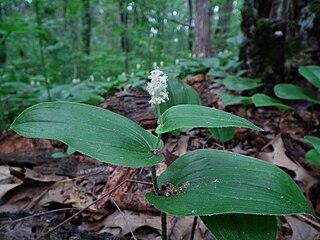
Maianthemum canadense is an understory perennial flowering plant, native to Canada and the northeastern United States, from Yukon and British Columbia east to Newfoundland, into St. Pierre and Miquelon. It can be found growing in both coniferous and deciduous forests. The plant appears in two forms, either as a single leaf rising from the ground with no fruiting structures or as a flowering/fruiting stem with two to three leaves. Flowering shoots have clusters of 12–25 starry-shaped, white flowers held above the leaves.

Maianthemum racemosum, the treacleberry, feathery false lily of the valley, false Solomon's seal, Solomon's plume or false spikenard, is a species of flowering plant native to North America. It is a common, widespread plant with numerous common names and synonyms, known from every US state except Hawaii, and from every Canadian province and territory, as well as from Mexico.
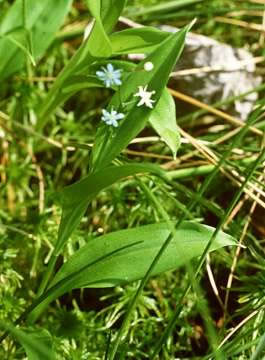
Maianthemum trifolium is a species of flowering plant that is associated with extremely wet environments and is native to Canada and the northeastern United States as well as St. Pierre and Miquelon and Asia (Siberia).

Crossosomataceae is a small plant family, consisting of four genera of shrubs found only in the dry parts of the American southwest and Mexico. This family has included up to ten species in the past, although as of 2021 six species are still recognised. Crossosoma are shrub-like plants which can vary from being 50 cm to 5 meters tall, with small alternating leaves that surround the stem, or leaves clustered in small spurts (fascicles). Apacheria, however, has opposite leaves. Crossosoma has usually white flowers that are generally bisexual and have 5 petals attached to a nectary disk, but in Velascoa the flowers are campanulate and have an extremely reduced nectary disk.

Tillandsia bartramii, commonly known as Bartram's airplant, is a species of flowering plant in the bromeliad family. It is native to Florida, South Carolina and southern Georgia in the United States as well as Guatemala and Mexico. The name honours William Bartram (1739–1823), an early Florida naturalist.

Aechmea lueddemanniana is a species of bromeliad in the genus Aechmea. This species is native to Costa Rica, Guatemala, Belize, Honduras, Nicaragua and southern Mexico as far north as Veracruz.

Aechmea mexicana is a plant species in the genus Aechmea. This species is native to central and southern Mexico, Central America, Colombia and Ecuador.
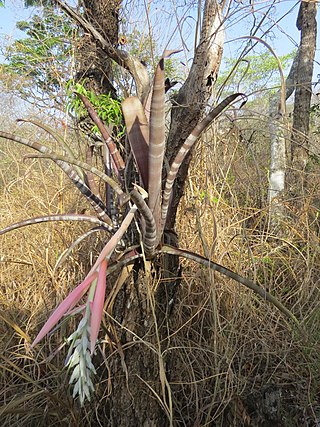
Billbergia pallidiflora is a species of flowering plant in the family Bromeliaceae. This species is native to Central America and western Mexico.
Catopsis subulata is a species in the genus Catopsis. This species is native to Mexico, Guatemala, and Honduras.
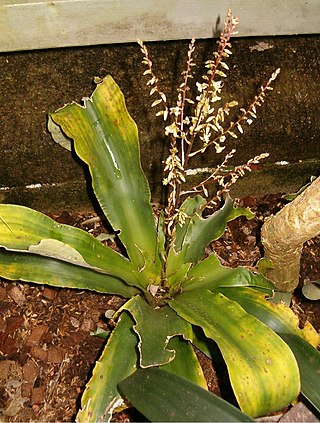
Fosterella micrantha is a plant species in the genus Fosterella. This species is native to Mexico, Guatemala, and El Salvador.
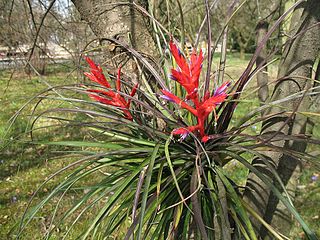
Tillandsia chlorophylla is a species of flowering plant in the genus Tillandsia. This species is native to Belize, Guatemala, and southern Mexico.
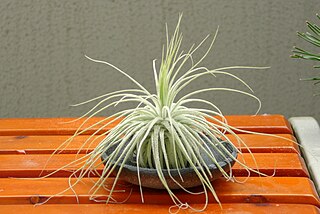
Tillandsia magnusiana is a species of flowering plant in the genus Tillandsia. This species is native to southern and western Mexico, El Salvador, Nicaragua and Honduras.

Maianthemum paniculatum is a perennial flowering plant; a species of monocot found from Mexico to Panama. It is often associated with montane environments and is found primarily in forest openings and along roadsides.
Maianthemum amoenum is a perennial flowering plant, growing as an epiphyte on trees in cloud forests from Mexico south to Honduras.
Maianthemum macrophyllum is a perennial flowering plant. It is a rare epiphtic herb endemic to Veracruz and Oaxaca, Mexico and is known only from primary cloud forests, usually growing on limbs of oaks or sweetgum.

Maianthemum scilloideum is a perennial flowering plant. It is a terrestrial forest herb from southern Mexico and Guatemala and also reported from Honduras.
Maianthemum flexuosum is a perennial, terrestrial understory herb of cloud forests from southern Mexico to Nicaragua. It has been found at sites from 1300 to 2800 m elevation.
Maianthemum salvinii is a rare perennial, epiphytic herb found in southern Mexico and Guatemala.
Maianthemum mexicanum is a perennial, terrestrial herb found as an understory species in moist forests. It is endemic to west-central Mexico.













